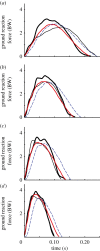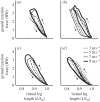Leg stiffness of sprinters using running-specific prostheses
- PMID: 22337629
- PMCID: PMC3385759
- DOI: 10.1098/rsif.2011.0877
Leg stiffness of sprinters using running-specific prostheses
Abstract
Running-specific prostheses (RSF) are designed to replicate the spring-like nature of biological legs (bioL) during running. However, it is not clear how these devices affect whole leg stiffness characteristics or running dynamics over a range of speeds. We used a simple spring-mass model to examine running mechanics across a range of speeds, in unilateral and bilateral transtibial amputees and performance-matched controls. We found significant differences between the affected leg (AL) of unilateral amputees and both ALs of bilateral amputees compared with the bioL of non-amputees for nearly every variable measured. Leg stiffness remained constant or increased with speed in bioL, but decreased with speed in legs with RSPs. The decrease in leg stiffness in legs with RSPs was mainly owing to a combination of lower peak ground reaction forces and increased leg compression with increasing speeds. Leg stiffness is an important parameter affecting contact time and the force exerted on the ground. It is likely that the fixed stiffness of the prosthesis coupled with differences in the limb posture required to run with the prosthesis limits the ability to modulate whole leg stiffness and the ability to apply high vertical ground reaction forces during sprinting.
Figures







Similar articles
-
Leg stiffness during sprinting in transfemoral amputees with running-specific prosthesis.Gait Posture. 2017 Jul;56:65-67. doi: 10.1016/j.gaitpost.2017.04.038. Epub 2017 May 4. Gait Posture. 2017. PMID: 28505545
-
Leg stiffness in unilateral transfemoral amputees across a range of running speeds.J Biomech. 2019 Feb 14;84:67-72. doi: 10.1016/j.jbiomech.2018.12.014. Epub 2018 Dec 20. J Biomech. 2019. PMID: 30587378
-
Running-specific prostheses limit ground-force during sprinting.Biol Lett. 2010 Apr 23;6(2):201-4. doi: 10.1098/rsbl.2009.0729. Epub 2009 Nov 4. Biol Lett. 2010. PMID: 19889694 Free PMC article.
-
Carbon fibre prostheses and running in amputees: a review.Foot Ankle Surg. 2008;14(3):125-9. doi: 10.1016/j.fas.2008.05.007. Epub 2008 Jul 14. Foot Ankle Surg. 2008. PMID: 19083629 Review.
-
Metabolic Cost and Performance of Athletes With Lower Limb Amputation and Nonamputee Matched Controls During Running: A Systematic Review.Am J Phys Med Rehabil. 2022 Jun 1;101(6):584-589. doi: 10.1097/PHM.0000000000001874. Epub 2021 Sep 3. Am J Phys Med Rehabil. 2022. PMID: 34483259
Cited by
-
Running in highly cushioned shoes increases leg stiffness and amplifies impact loading.Sci Rep. 2018 Nov 30;8(1):17496. doi: 10.1038/s41598-018-35980-6. Sci Rep. 2018. PMID: 30504822 Free PMC article.
-
'Whip from the hip': thigh angular motion, ground contact mechanics, and running speed.Biol Open. 2020 Oct 21;9(10):bio053546. doi: 10.1242/bio.053546. Biol Open. 2020. PMID: 32917763 Free PMC article.
-
The contribution of lower-limb joint quasi-stiffness to theoretical leg stiffness during level, uphill and downhill running at different speeds.R Soc Open Sci. 2024 Apr 17;11(4):231133. doi: 10.1098/rsos.231133. eCollection 2024 Apr. R Soc Open Sci. 2024. PMID: 38633349 Free PMC article.
-
Effect of running speed and leg prostheses on mediolateral foot placement and its variability.PLoS One. 2015 Jan 15;10(1):e0115637. doi: 10.1371/journal.pone.0115637. eCollection 2015. PLoS One. 2015. PMID: 25590634 Free PMC article.
-
Joint moments during sprinting in unilateral transfemoral amputees wearing running-specific prostheses.Biol Open. 2019 Feb 18;8(2):bio039206. doi: 10.1242/bio.039206. Biol Open. 2019. PMID: 30674461 Free PMC article.
References
-
- Grabowski A. M., McGowan C. P., McDermott W. J., Beale M. T., Kram R., Herr H. M. 2010. Running-specific prostheses limit ground-force during sprinting. Biol. Lett. 6, 201–20410.1098/rsbl.2009.0729 (doi:10.1098/rsbl.2009.0729) - DOI - DOI - PMC - PubMed
-
- Weyand P. G., Bundle M. W., McGowan C. P., Grabowski A., Brown M. B., Kram R., Herr H. 2009. The fastest runner on artificial legs: different limbs, similar function? J. Appl. Physiol. 107, 903–91110.1152/japplphysiol.00174.2009 (doi:10.1152/japplphysiol.00174.2009) - DOI - DOI - PubMed
-
- Alexander R. M. 1992. A model of bipedal locomotion on compliant legs. Phil. Trans. R. Soc. Lond. B 338, 189–19810.1098/rstb.1992.0138 (doi:10.1098/rstb.1992.0138) - DOI - DOI - PubMed
-
- Blickhan R. 1989. The spring–mass model for running and hopping. J. Biomech. 22, 1217–122710.1016/0021-9290(89)90224-8 (doi:10.1016/0021-9290(89)90224-8) - DOI - DOI - PubMed
-
- Blickhan R., Full R. J. 1993. Similarity in multilegged locomotion: bouncing like a monopode. J. Comp. Physiol. A 173, 509–517
Publication types
MeSH terms
LinkOut - more resources
Full Text Sources
Medical
Miscellaneous

